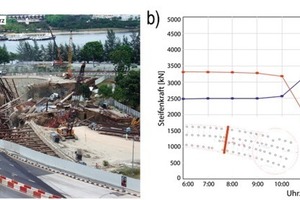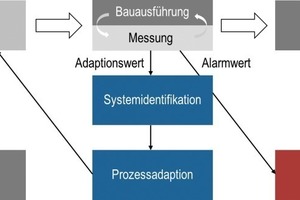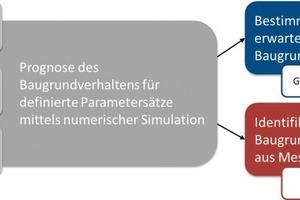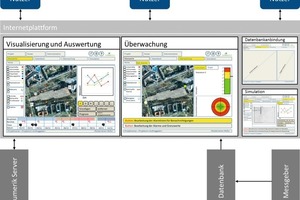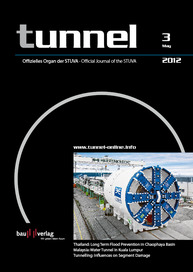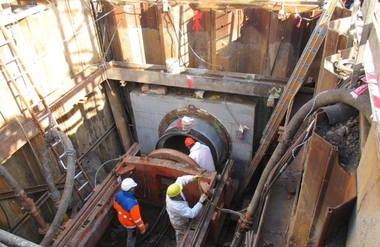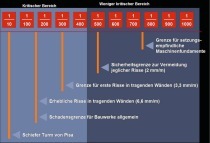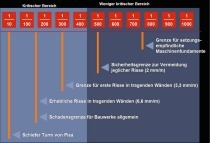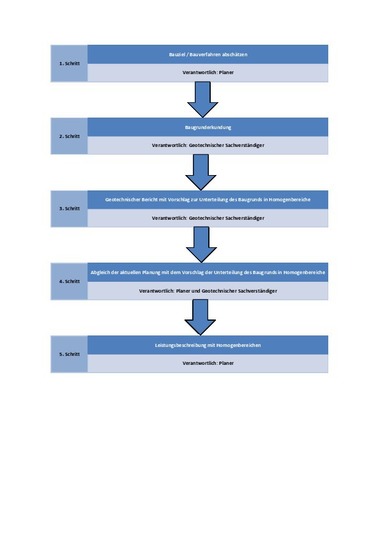Observation Method Geotechnics – Interlinking Measurements and Simulation
Urban, geotechnical construction projects are associated with risks such as possible damage to existing buildings. Necessary exact awareness of the subsoil prior to the construction scheme represents a determining cause for the existence of such risks. The observation measure according to DIN 1054 defines the norm-based principle for ongoing improvement of the information available about the subsoil as the project progresses. Thanks to the fact that the improved basis for planning is incorporated in the construction process risks of damage and other potential dangers can be identified prior to their occurrence and the construction measure optimised. The core element of the presented methodics relates to interlinking an automated, measurement technical recording of the subsoil conditions and the resultant prognosis taking avail of numerical simulation models. The report is based on initial results from the GeoTechControl joint research project (www.geotechcontrol.de).
1 Motivation and Background
The recorded geological situation represents the basis for planning geotechnical construction measures alongside the structural-specific demands on utilisation, suitability and sustainability. The design of the bearing structure for the building and its dimensions as well as the choice of the production methods suitable for carrying out the scheme depend on them. The information relating to the subsoil that is of use during the conception of the structure and the methods is out of sheer necessity full of uncertainties. The number of exploratory drill holes is restricted and is only capable of providing an incomplete picture of the geometry as well as the variability of the soil parameters within the layers of strata. Furthermore the characteristic values pertaining to the subsoil derived from such investigations to a certain extent fluctuate from the actual subsoil conditions owing to the soil samples being disturbed upon removal and the difference in scale between the sample and subsoil layer. In order to attain the desired safety level the structural draft is thus based on a subsoil recording for parameter areas, the so-called upper and lower characteristic values.
In spite of the fact that this procedure generally results in an over-dimensioned structural design, spectacular cases of damage constantly result during geotechnical construction schemes (Fig. 1; Wannick, 2007; COI, 2005). Especially whenever individual failure mechanisms are not correctly identified during planning or could not be identified from the subsoil recording.
In addition an essential main element of complex geotechnical construction measures consists of ensuring that a large number of different special foundation engineering and tunnelling methods are combined. Particularly for urban construction schemes there is always a process of considering whether prophylactic safety measures with the related influencing of the subsoil should be embarked on or whether to select reactive measures, which should only be applied in a case of need.
First and foremost it is demanded of a construction measure that any negative effects on neighbouring buildings in the surrounding area, especially in an urban one, should be minimised. This minimising process is often linked to the introduction of further geotechnical construction measures and thus on the other hand denotes intervention in the structure of the subsoil and in turn a change in the properties of the soil. These for their part generally influence the construction methods.
As a result consistent risk observation taking all risk components into account for geotechnical measures is essential involving systematic danger identification, extensive investigation of the consequences and effects resulting from such dangers quite apart from the logical planning of safety measures. Risk management of this nature is only successful if it is followed up during execution of construction quite apart from ensuring that the findings obtained are incorporated in adapting the concept.
1.2 Gaining Information through Observation
The DIN 1054 (Subsoil – Safety Proofs in Earthworks and Foundation Engineering) and the EC 7 define the observation method as the normative principle for adapting construction methods and construction measures to the subsoil behaviour observed as construction progresses (Gudehus, 2004). The observation method can thus be purposively applied to improve the still inaccurate recording of the subsoil situation during the planning phase through observations and to adapt the construction measure in keeping with the new findings and apply this in the interests of minimising risks. The prerequisite here is the possibility to be able to react to the observed subsoil behaviour by introducing measures for curbing danger or adapting execution during the construction phase.
2 Stage reached by Technology
Within the scope of conventional tunnel drives the cycle governing the observation method of construction progress, evaluation of the subsoil condition and adaptation of the construction process represents an integral component of the construction method (Moritz and Schubert, 2009).
For construction measures in urban areas involving an enhanced risk of damage such as for example deep construction pits or undertunnelling existing buildings, the large-scale observation of critical measurement points and parameters is state of the art. Self-sustaining measurement systems, methods for the automated importing of the recorded measurement data in central data banks as well as for evaluating and visualising them and automatic notification in the event of alarm are commercially available (e.g. Maidl, 2008, Chmelina and Rabensteiner, 2010). Internet technologies are being applied increasingly so that the results are made available to those involved in the project without delay.
Although commercial programmes are available for measurement technical recording and control, the coupling of simulation-based prediction of the subsoil behaviour and its measurement technical recording is something still being looked into by research and development. Numerical computational methods are in the meantime an established component of engineering practice (e.g. Nagel, Stascheit and Meschke, 2010).
3 The Observation Method after DIN 1054
The observation method complements the sequential construction cycle consisting of planning and execution through the flowback of the findings obtained during progress in construction into planning (Fig. 2). The norm text (DIN 1054: 4.5 (1)) specifies the relevant procedure:
“The observation method is a combination of conventional geotechnical investigations and calculations (prognoses) through ongoing measurement technical control of the structure and the subsoil during its production […], whereby critical situations must be mastered by applying technical measures”.
The application of the observation is thus divided into 3 partial tasks:
• Recording the subsoil behaviour during execution of construction (measurement technical control),
• Comparing the subsoil reaction recorded in this way with the expected parameters (prognosis) as well as
• Introducing a reaction to counter danger (measures) in the event of danger.
The norm expressly includes application for optimising the dimensioning.
All 3 partial tasks call for intensive advance planning and collaboration of those involved in the construction scheme. The applied measurement programme must embrace any deviation in the sensitive parameters in the subsoil parameters on which the planning is based as well as the critical parameters pertaining to damage to the structure and its surroundings. For the observation and interpretation of the measurement data thus recorded first of all a prognosis of the expected subsoil behaviour is required. Measurement value ranges are to be established in keeping with this prognosis, within whose limits validity for the planning assumptions can be presupposed. These limits for the validity of the planning principles are backed up by alarm values, which represent indicators for critical measurement value curves. Apart from the examination of the limit values accompanying the construction process the possibility of adapting planning as well as introducing measures to counter danger through the construction measure must be assured.
4 Interlinking Measurement Technical Observation and Simulation
Incorporating the prognosis of the subsoil reactions through numerical simulation models takes place in 2 steps for computer-supported application of the observation method. Simulation models can on the one hand be used to determine measurement ranges, in which the planning principles are valid, and on the other the subsoil recording can be improved upon vacating these measurement ranges by recalculating the recorded subsoil behaviour (Fig. 3). Thanks to numerical simulation models the interactions between subsoil and construction process can be depicted in the prognosis and also 3-dimensional, process-related predictions made. Three prior conditions are needed for a reliable prognosis:
1. a subsoil recording, which defines confidence ranges for the individual subsoil parameters
2. a realistic reproduction of the subsoil behaviour
3. Modelling of the entire construction process incl. all partial steps as well as its interactions with the surrounding subsoil.
Once these prerequisites are fulfilled, points of support are formed for the confidence intervals of the subsoil parameters defined in the subsoil recording to determine the measurement value ranges, in which the planning principles possess validity, for which simulation cycles are undertaken from the resultant parameter sets and the corresponding limit values derived from the spread of results. Should these limit values be violated during the execution of construction then the subsoil behaviour must be redefined. Towards this end, the parameter range to be investigated is extended and simulations carried out in similar fashion to the procedure previously described. The parameter set corresponding to the best-fit between the measurement values and simulation results represents the improved subsoil information.
5 Evaluation via Internet Platform
Within the scope of the methods devised by the GeoTechControl research project to apply the observation method in construction practice the developed tools are made available to users via an internet platform (Fig. 4). This facilitates central processing and provision of all data and in turn, a consistent and simultaneous flow of information to those involved. In addition, in this way information and tools are available off-line and a barrier-free inclusion of remote computer and data bank resources facilitated. Users are supported in analysing the recorded measurement data via the internet platform: visualisation tools enable the existing measurement data to be presented and evaluated in a lucid manner; critical measurement value cycles can be identified at an early stage thanks to automated examination of and alerting to the defined limit and alarm values.
6 Summary
Thanks to the presented methods for interlinking numerical simulation to forecast the subsoil behaviour and its measurement technical observation a structured, computer-supported application of the observation method is strived for in construction practice. This involves the incorporation of computer-supported methods to evaluate and interpret the recorded measurement data. The results of the measurement technical observation can be interpreted through comparison with prognosed soil reactions regarding the validity of planning assumptions. Thanks to the possibility of system identification by recalculation of the recorded measurement data the available information relating to the subsoil can be constantly improved as construction progresses. The automated evaluation and visualisation of the measurement data enable critical measurement value developments to be identified at an early stage. Through defining suitable limit values in advance of the construction measure by applying established numerical models, the observation method is applied both in an objective and balanced manner. Within the framework of a structured design process, possible deviation scenarios are specified and damage risks identified. Possible planning adaptations and measures to avoid danger are determined and provided in advance of the construction measure.
The consistent application of the observation method by introducing the presented processes and systems currently being developed in the GeoTechControl research project can on the one hand enhance the construction measure’s economy whilst retaining the safety level and on the other safety against residual risks can be improved through recognising critical measurement value developments at an early stage. Through introducing decisions of an objective and balanced nature within the scope of the structured design process an effort is made to deal with the risks of the observed construction measure transparently.
The author would like to thank the Federal Ministry for Education and Research for sponsoring this report financially within the framework of the KMU-innovativ – Verbundprojekt GeoTechControl research project – Service Portal for Monitoring and Prognosis Geotechnical Engineering Structures (01IS10018B). Apart from ZERNA INGENIEURE GmbH the GeoTechControl consortium includes ELE beratende Ingenieure, the TU Dresden and FIDES DV-Partner.

